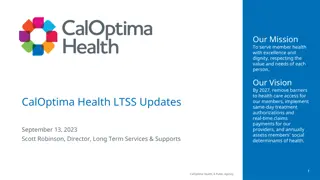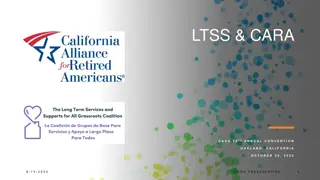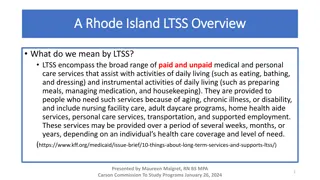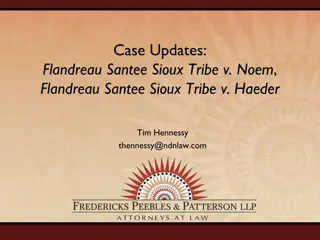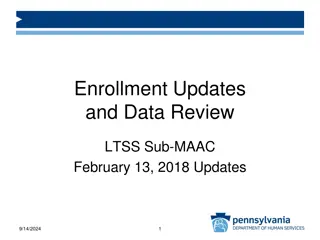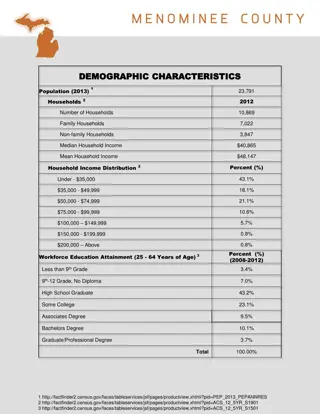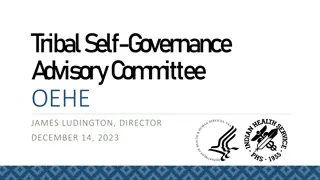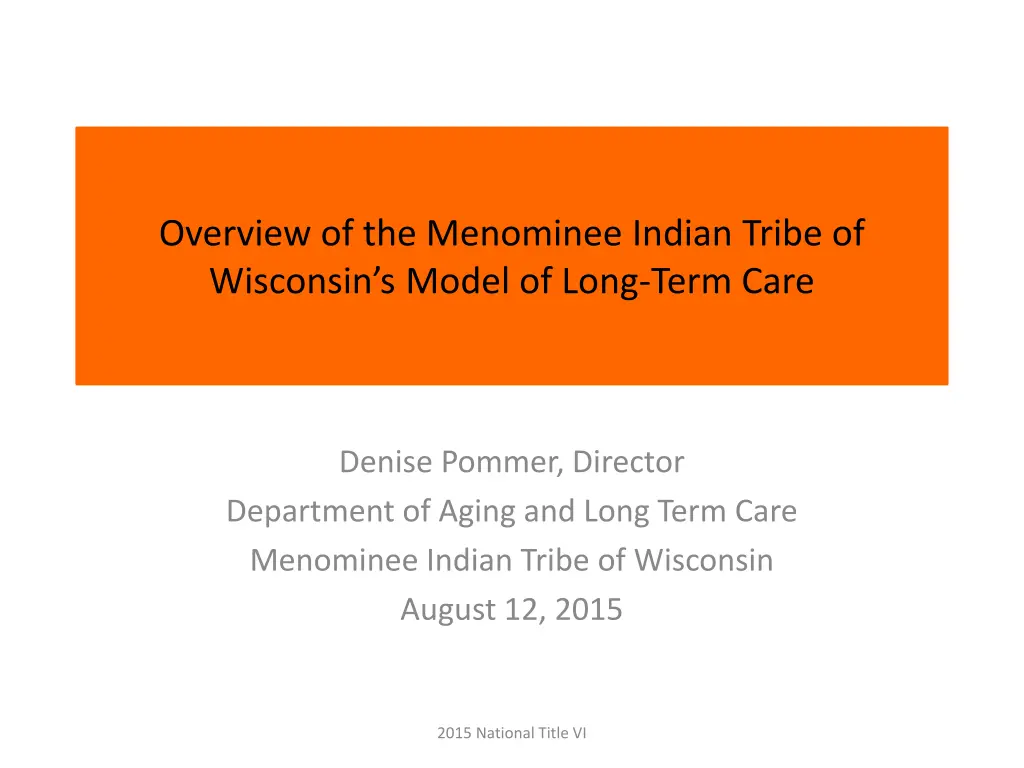
Menominee Tribe of Wisconsin Long-Term Care Model Overview
Explore the Menominee Indian Tribe of Wisconsin's model of long-term care focusing on key goals, challenges, and initiatives to improve health and provide culturally competent services for tribal members. Learn about the unique circumstances, socio-economic factors, and efforts to sustain a long-term care program aligned with Tribal Sovereignty.
Download Presentation

Please find below an Image/Link to download the presentation.
The content on the website is provided AS IS for your information and personal use only. It may not be sold, licensed, or shared on other websites without obtaining consent from the author. If you encounter any issues during the download, it is possible that the publisher has removed the file from their server.
You are allowed to download the files provided on this website for personal or commercial use, subject to the condition that they are used lawfully. All files are the property of their respective owners.
The content on the website is provided AS IS for your information and personal use only. It may not be sold, licensed, or shared on other websites without obtaining consent from the author.
E N D
Presentation Transcript
Overview of the Menominee Indian Tribe of Wisconsin s Model of Long-Term Care Denise Pommer, Director Department of Aging and Long Term Care Menominee Indian Tribe of Wisconsin August 12, 2015 2015 National Title VI
A Glance at the Menominee Tribe Location and U.S. Census Data Located in the State of Wisconsin the Menominee Indian Reservation is largely coterminous with Menominee County Reservation land base is 235,523 of which roughly 223,500 acres are heavily forested 84.5% of the 4,317 population estimates for 2013 are Native American Per capita income in 2012 dollars was $14,479 23.2% of people live below the poverty level 2015 National Title VI
The Tribe at a Glance 2014 Wisconsin County Health Rankings Menominee County ranks 72 out of the 72 counties in the state ranking last in health behaviors, factors, and outcomes, social and economic factors, and mortality Unemployment in 2014 is 15.3% (compared to 5.2% State of Wisconsin rate and 6.2% 2014 National annual average -U.S. Bureau of Labor Statistics) 47% of children live in poverty 16% experience severe housing problems 17% are in poor or fair health (12% in the state) Premature death is 63% higher than the state and 66.6% higher than the National benchmark 2015 National Title VI
Why the Tribal Waiver Program is Important (key goals) Given the expanse and rural land base where our population lives it is thought that isolation, early onset of chronic disease, unemployment, poverty, historical trauma and reluctance of membership to seek outside services are among the many concerning factors and challenges that contribute to the health care gap in critical risk areas experienced by Menominee people. The key goals of the program include to: improve health and mortality maintain a culturally competent service delivery system afford a trusted alternative that improves access to care and health care utilization 2015 National Title VI
Key Goals (continued) keep Tribal members in their homes, within the community, and out of costly institutions improve timeliness of service delivery improve living conditions promote job creation strengthen the Menominee Tribal economic base expand the role for Tribal departments thereby alleviate the Tribe s financial challenge to provide services sustain a long-term care program that aligns with Tribal Sovereignty and Self Determination 2015 National Title VI
Identifying Stakeholders Tribal Leadership (requires buy-in) State Department of Health Services Tribal departments County Health and Human Services Tribal or local college Local Nursing Homes and Hospital Waiver participants and family members Aging and Disability Resource Center (ADRC) 2015 National Title VI
The Menominee Model of Long-Term Care Conceptualized in 2012, the concept of the Menominee Model of Long Term Care is that it is not just an agency providing care, rather this is a community caring for its own people Administered through the Tribe s Department of Aging and Long Term Care - Director is responsible for and provides oversight of overall program operations Program serves Indian Health Service/waiver eligible persons Financial and Functional Eligibility: Tribal Income Maintenance Department determines financial eligibility ADRC and/or Tribal Aging and Disability Resource Specialist conduct functional screens, outreach, and provide options counseling Case Management (Tribal Hires and Contracted) Service consistent with tribal values and beliefs Limited case management, HSRS, coordinates the Supportive Home Care worker pool, and other LTC Administrative Coordinator 2015 National Title VI
Menominee Model (continued) Participant is the employer Contracted fiscal agent Home Repair Program Funded with county cost savings Collaboration with the College of Menominee Nation for pool of qualified Supportive Home Care workers Utilize Tribal departments and private Tribal entrepreneurs as potential service providers 2015 National Title VI
Of Significance in the Menominee Model of LTC Expanded role for Tribal departments and Tribal members in service delivery provides added CHOICE of culturally competent providers Opportunities for economic development for Tribal members, businesses that exist or may be developed Increased number of eligible waiver participants from 32 to 140 There are currently over 100 supportive home care workers employed No greater cultural competence than the Tribe caring for its own members 2015 National Title VI
Of Significance in the Menominee Model of LTC Forged a partnership and strong working relationship with the State DHS A Tribal/County Human Services Planning Committee serves to address the coordination and integration of long-term care services to residents of the Reservation/County Benefits the state, the county and of greatest importance to the Tribe: the waiver program serves as a viable avenue for the Tribe to address the health, social, and mortality concerns by utilizing third party revenue to reduce the shortfall between capacity and need thereby helping to meet the financial challenges that the Tribe and Tribal members face 2015 National Title VI
Sustainability Implementing long term services and supports is made possible by language that amends the Indian Health Care Improvement Act of 2009 and included in the Affordable Care Act Provides Indian Health Service specific authorities for provision of long term care services provided to American Indian/Alaskan Natives in IHS or tribal facilities Tribes must include LTSS language in their Tribal 638 health contract 100% Federal Medical Assistance Percentage Claims are processed throughout the year so payments are received on an ongoing basis Administrative fee received based on total cost of services 2015 National Title VI
In Summary The Menominee Model of Long-Term Care is a leading example of how the Menominee Indian Tribe of Wisconsin is exercising its right to self-governance and self-determination to meet the unique needs, culture, values, and expectations of the Tribal community. The demonstrated capability of the Menominee Tribe to successfully administer a 1915(c) Medicaid Waiver program provides HCBS that support a culturally appropriate service delivery system and is a trusted alternative that improves access and health care utilization for Tribal members who might otherwise go with out services. The program expands roles for Tribal departments, Tribal members, and provides opportunities for economic development for businesses that exist or may be developed; promotes positive health outcomes and well-being; and is a most viable avenue to deliver critically needed long term services and supports before life is lost or costly institutionalization is necessary. The Menominee Model of LTC has been shared with other Wisconsin Tribes and Tribes across the Nation and recommendations made to Tribes includes to view the Long Term Services and Supports (LTSS) in Indian Country A Roadmap for Planning at CMS.gov 2015 National Title VI
In Summary As the State of Wisconsin expands its Managed Care Model, Family Care, and Self Directed Supports Model, IRIS, the Menominee Indian Tribe exercises its status as a Sovereign Nation with the inherent right to self-governance to develop and implement a federal program that directly impacts the Tribe and our Tribal members. The Tribe together with the State of Wisconsin are strong proponents of a new 1915 (c) waiver application for a Tribal Only Waiver option that is recently submitted to the Centers for Medicare and Medicaid Services for authorization and inclusion in the Wisconsin State Plan Amendment. CMS authorization of the new 1915 (c) waiver for Sovereign Tribal Nations to administer the Medicaid waiver program is essential to sustain the Menominee Model of Long-Term Care 2015 National Title VI

